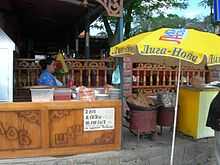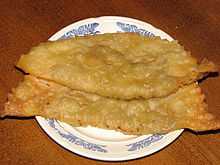Crimean Tatar cuisine

The Crimean Tatar cuisine is primarily the cuisine of the Crimean Tatars, who live on the Crimean Peninsula in Ukraine.
Crimean Tatars have lived on the Black Sea peninsula of Crimea at least since the 13th century. In 1944, they were unjustly accused by Joseph Stalin of collaborating with the Nazi occupiers during World War II and some 500,000 Crimean Tatars were deported to Central Asia. In the early 1990s, after nearly five decades in exile, approximately 250,000 Crimean Tatars decided to return to Crimea, officially a part of the Ukrainian Soviet Socialist Republic since 1954. The Tatars living in Crimea today are a minority on the peninsula, accounting for 12% of the population of Crimea. Other countries with significant population of Crimean Tatars are Uzbekistan, Russia, Turkey, and Romania.
The traditional cuisine of the Crimean Tatars derives basically from the same roots as the cuisine of the Volga Tatars, although unlike the Volga Tatars they do not eat horse meat and do not drink mare’s milk (kymyz). However, the Crimean Tatars adopted many Uzbek dishes during their exile in Central Asia since 1944, and these dishes have been absorbed into Crimean Tatar national cuisine after their return to Crimea. Uzbek samsa, laghman, and plov (pilaf) are sold in most Tatar roadside cafes in Crimea as national dishes. Uzbek flatbread, nan (or lepyoshka in Russian), is also a staple among Crimean Tatars.
Traditional dishes
- Chee-börek (or Chiburekki) is a fried turnover with a filling of ground or minced meat and onions. Similar to the peremech of the Volga Tatars, but made with one round piece of dough folded over the filling in a half-moon shape. A national dish of the Crimean Tatars, it is also popular in Crimean Tatar diasporas in Turkey, Romania, Russia, and Uzbekistan.
- Sarburma
- Yantik, a chee-börek that is grilled, not fried.
- Köbete, a traditional pie with a rice-and-chicken filling baked between two layers of dough. Served as a main course, köbete can be made with alternative fillings, such as rice and meat, meat with potatoes and onions, or even potatoes and cheese.
- Tabak börek, small dumplings with a meat filling cooked in a broth and served as a main dish or in a soup (kashik börek). Similar to the pilmän of the Volga Tatars, the Uzbek chuchvara, or the generic manty in Central Asian cuisines.
- Göbädiä (or gubadia), a wedding pie with layers of meat, rice, chopped eggs, raisins, and qurt (dry white cheese). The equivalent of the eponymous dish in the cuisine of Volga Tatars.
- Shurpa, a Central Asian meat soup with large pieces of beef and mutton, onion, carrots, and other vegetables.
- Bakla ash, a soup made from green peas or beans, an unusual vegetarian dish in a meat-eating Tatar culture.
- Sheker keyeks, a traditional dessert, similar to the Turkish baklava.
See also
References
- Crimean diet a century ago, including recipes of traditional Crimean Tatar dishes. Retrieved on 16 May 2009
- G. R. Mack and A. Surina, Food culture in Russia and Central Asia, Greenwood Publishing Group, 2005, ISBN 0-313-32773-4, ISBN 978-0-313-32773-5. Can be partially viewed on Google Books. Retrieved on 16 May 2009
- S. Johnstone and G. Bloom, Ukraine, Lonely Planet, 2008, p. 197, ISBN 1-74104-481-2, ISBN 978-1-74104-481-2. Can be partially viewed on Google Books. Retrieved on 16 May 2009
- A gallery of Crimean Tatar food, International Committee for Crimea, Washington, DC. Retrieved on 16 May 2009
| |||||||||||
